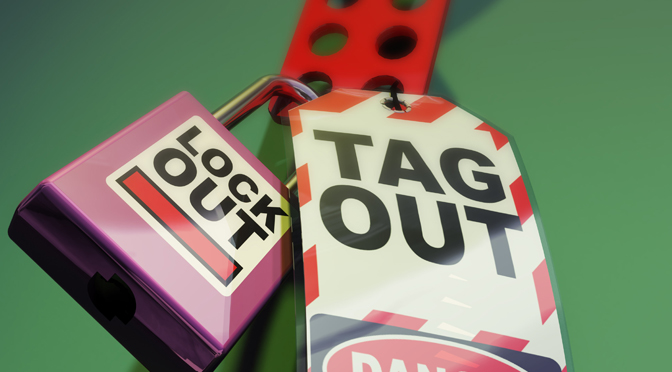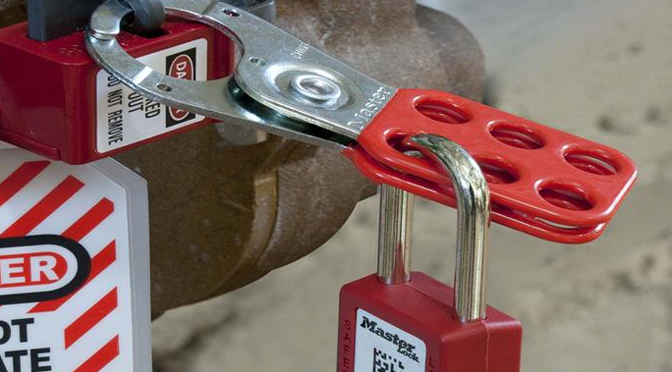
Elements Of OSHA’s Lockout-Tagout Standard
The elements of Osha Lockout Tagout Standard (29 CFR 1910.147) is a 4-page general industry standard, which was first published in 1989. It was formulated with the single aim of preventing accidental startups of machineries and equipments during their maintenance or service. It lays importance on isolating hazardous energy sources and rendering them isolated. The energy sources include hydraulic, thermal, electrical (stored and active current), chemical, gravitational force, pneumatic and mechanical.
A lockout/tagout program includes 3 basic elements:
1. Written Procedures: These written procedures communicate important information workers involved in lockout/tagout procedures and identify what needs to be done and when. They also prescribe the processes of shutdown, isolation and applying and removing lockout/tagout. Such procedures are only needed for machineries with 2 or more energy sources.
The following should be clearly specified:
– Specific machineries and their shutdown/isolation processes
– Where the lockout devices are installed
– How to de-energize stored energy
– How isolation needs to be verified
2. Training Programs: Training is mandatory for two types of employees, namely authorized employees and affected employees, where the former the people who maintain and service machineries and are qualified enough to control hazardous energies, and the latter are those work in close proximity to the machines/equipments being serviced or repaired under lockout/tagout and need to understand the hazards involved.
3. Timely Audits: Periodic audits ensure that the energy control procedures continue to be correctly implemented, the workforce do not deviate from the procedures and are familiar with their responsibilities. It must take place at least annually. These are also helpful in correcting procedural inadequacies.
Basic steps to lockout/tagout program:
1. Preparation – Think and Plan: Think through the entire procedure. Identify the energy sources that must be controlled and the methods which would be used.
2. Communicate and Notify: The authorized personnel needs to communicate the following to the affected employees:
– The machine that would be locked out and why
– How long will the process take
– Name of the employee responsible for lockout
– Who needs to be contacted for further information
3. Neutralizing the Equipments: It involves disconnecting the electricity, blocking the movable parts, releasing the spring energy, draining or bleeding hydraulic/pneumatic lines and lowering the suspended parts to rest positions.
4. Locking Out: Use lockout devices specific to the machinery. There should be as many locks as the people involved in the process and each person should have a personal lock and key placed on the machinery. Further, it should be noted that locks can only be unlocked by those who installed them.
5. Tagging Out: Tag the machineries, controls, and suspended parts. Tags should also include the contact details of and reasons for locking out.
Verify: Before you continue further, verify if the setup is completely locked out or not.
Checkout Our Other Lockout Tagout Products:
- Scaffold Tag
- MCB Lockout
- Lockout Padlocks
Enquire Now

Importance of OSHA’s Lockout/ Tagout Standards
OSHA (Occupational Safety and Health Administration) is a U. S. Government office entrusted with shielding and directing exercises in the working environment. As a major aspect of the U. S. Work Department, they are in charge of implementing well being and well being benchmarks in each area of business and industry. The directions they have instituted particular to ‘Lockout/Tagout’ are intended to ensure faculty dealing with stimulated hardware for the reasons for set up, adjusting and upkeep.OSHA Lockout Tagout Standards
There are particular enterprises that either are essentially not secured nor have their own particular principles on lockout/tagout for the purpose of warehouse safety:
• While there are other OSHA principles that apply for electrical stun and consume danger, the general standard does not matter to electrical risks from work on, close, or with transmitters or gear in electric use (start wiring) establishments, which are laid out by Subpart S of 29 CFR Part 1910.
• Controlling risky vitality in establishments for the selective reason for power era, transmission, and appropriation, including related gear for correspondence or metering (these sorts of establishments are secured by 29 CFR1910.269).
• Agriculture, development, and oceanic enterprises or oil and gas well boring and overhauling are not secured by the OSHA general standard on lockout/tagout.
The safety programs require significant investment a composed program, including gear particular methods must be established and representatives must be prepared and cash an adequate number of vitality detaching gadgets, (for example, locks) must be acquired and kept up and is regularly observed as badly designed. Therefore, a few managers will attempt to fit a circumstance into an exemption trying to work around the LOTO products and devices for direction since they would prefer not to manage the time, exertion, and burden. In any case, these programs anticipate the occurrence of chances frequently bringing about funds in specialists’ pay costs much more than that of the lockout/tagout program-and spares lives. On the off chance that a machine or bit of gear really does not should be stimulated amid adjusting or support, it ought to be bolted out.
A bolt out gadget is intended to physically cripple a bit of gear absolutely, in this manner keeping its inadvertent operation. These can be as switches on an electrical board or chains and bolts on a valve. Pins, key-squares and wedges are altogether utilized as a part of various applications. Just particular locking systems ought to be utilized on particular bits of gear. Where physical lockout is impractical, a tagout framework will give visual cautioning with regards to the threat display. They will regularly clarify the reason a specific machine is out of administration and demonstrate the person(s) in charge of playing out the important upkeep. Labels are just used to give data and are not a suitable substitute for a locking instrument, if locking is conceivable.
Inability to initiate and take after a compelling Lockout/Tagout program can open laborers to genuine damage and even demise. Numerous wounds have been avoided by appropriately taking after these vital rules. The vast majority of it is judgment skills. Like the directions going with any electrical apparatus in your home, the best exhortation is to “separate from the power before adjusting”.
Checkout Our Other Lockout Tagout Products:
- Scaffold Tag
- MCB Lockout
- Lockout Padlocks
Enquire Now

Common Yet Useful Lockout Devices
1. Circuit Breaker Lockout Devices: These are automatic electrical switches that are designed to protect circuit boards from overload or short circuit. At Lockout India, circuit breakers are designed to work on most varieties of breakers including single-pole and multi-pole breaker specifications.
These are used to isolate a given breaker in a panel so there’s no further need to lockout the entire breaker. Molded from durable plastics, their basic task however is to detect faulty conditions and automatically open the circuit.
2. Valve and Pneumatic Lockout Devices: Just like electricity, gases and fluids can be significantly hazardous. They tend to move at tremendous pressures and can severely injure if released inappropriately. Valve lockout devices are designed to isolate such hydraulic energy sources. There are different types of available valves such as ball valves, butterfly valves, gate valves, and pneumatic disconnects.
3. Plug Lockout Devices: Portable cords and connected plugs are a common site in work facilities. However, it is important to isolate such electrical sources into a socket using a power plug if one needs to comply with OSHA’s standards.
Our secure design locks onto prongs to prevent them from getting inserted into wall outlets. It can be used with your existing lockout hasps and padlocks.
4. Cable Lockout Devices: This device secures, holds, and locks out electrical power handles and gate valves. Cable lockout devices are conveniently isolated energy and are easy to use. They further ensure successful lockout across multiple energy sources and stop the workforce from actualizing devices while the maintenance is being carried out.
5. Lockout Hasp: Hasp lockout devices are an integral part of a successful safety program. They provide multi-person lockout and multiple padlocks can be applied hasps, allowing the energy to be isolated by more than one worker at a time.
Energy cannot be worked upon until each worker unlocks the padlock. Our wide range of hasps includes dielectric hasps, dual jaw hasps, electroplated hasps, labeled hasps, premier lockout hasps, and non-conductive hasps.
When are these devices used?
– While machinery is being serviced or maintained
– While installing new equipments and machineries
– When a safety device needs to be bypassed or removed
– Moving machineries and equipments
– Any machinery prone to unexpected start-up
Most importantly, whenever a lockout safety device is applied to a machinery, it must remain under exclusive observation and shouldn’t be removed by any unauthorized personnel. manufacturer of lockout products
Checkout Our Other Lockout Tagout Products:
- Scaffold Tag
- MCB Lockout
- Lockout Padlocks
Enquire Now
Also read: How to Use Electrical Lockout Devices and Equipment?
Also read: Types of Lockout Tags & Its Usage for Industrial Safety


